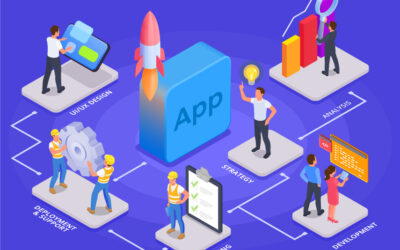An online business that succeeds is built on the e-commerce technology stack. It’s critical to prioritize a flawless user experience and interaction with other company processes when selecting the appropriate technological stack for your e-commerce store.
We examine the key elements that affect e-commerce businesses, including e-commerce platforms, in more detail in this tutorial. This makes it easier to investigate problems with several solutions.
You will have a thorough understanding of the different aspects to take into account when selecting the best e-commerce platform for your technological stack after reading this article. You are fully equipped with all the information required to make a wise choice.
What is an e-commerce technology stack?
The term “e-commerce technology stack,” or “tech stack,” describes the group of software programs. It is compatible with various online shops or e-commerce procedures.
When creating an e-commerce store, there are a number of software programs and technological choices to take into account. Depending on individual requirements, every aspect of e-commerce operations, including delivery options, inventory management, and payment processing, can employ a different software stack.
Tools, frameworks, platforms, apps, and more programming languages make up e-commerce stacks.
Your enterprise e-commerce tech stack has two different aspects –
- The front end
- Back end
The languages and software used to create and design websites and storefronts are together referred to as the front-end stack. However, the server, application, and database that operate in the background to provide clients with information make up your backend stack.
What Should You Consider When Selecting an eCommerce Tech Stack?
If you have to make the best decision for your business, it is important to consider the following factors when selecting an e-commerce tech stack.
1. Customizability
You can create an amazing shopping experience that is appealing to the intended audience with increased customizability. A fashion retailer, for instance, might want to create a homepage that is appealing to the eye and includes product showcases in the form of image movies. Correlation outlines and intensive item specs can help out from a tech store. The freedom to create individual shopping experiences is enhanced by increased customizability. More technological know-how and resources are required for enhanced customization. For example, web improvement ability is expected to adjust the codebase and configuration layouts while utilizing open-source frameworks like WooCommerce or Magento. On the other hand, a platform like Shopify is easy to use thanks to its customizable interface and pre-built themes. In any case, this offers no level of control.
2. Integration Options
The efficiency and operation of your e-commerce site might be affected by the availability of plugins and integrations. To automate email campaigns, for example, integration with an email marketing platform is helpful. Using an ERP integration can make operations easier. In order to create seamless experiences for both customers and the internal team, you must make sure that the platform you have chosen supports the necessary connectors.
While assessing mix choices, consider these utilization cases –
- CRM mixes assist with overseeing client information and correspondence. Email showcasing mixes assist with computerizing email crusades as well as advancements.
- Item stock administration assists track with loading levels and oversee orders.
Integrations with social media platforms can assist in product promotion and customer interaction.
Integrations with Analytics can be used to monitor user behavior and website performance.
3. Scalability
Scalability is a critical consideration in the selection of an eCommerce platform. The infrastructure of your website may become more and more in demand as your business expands. For instance, a larger product catalog would require extensive research and filtering choices, while an increase in website traffic might necessitate additional server resources. Built-in scalability allows platforms like Bigcommerce and Shopify to adapt their infrastructure to meet increasing demand. Scaling requirements for open source platforms like WooCommerce and Magento could include increasing website performance or hosting plan upgrades.
4. Cost
The cost is the following essential component. Contingent upon the arrangement you select, the all out cost of building and dealing with an online business stage can vary fundamentally. It’s important to keep a few things in mind. A couple of these are –
- one-time costs like membership fees or purchases.
- Payment gateways assess transaction fees.
- The cost of subjects, modules, and different connections.
- the costs of building and maintaining a website.
For instance, WooCommerce is free, though Shopify has a month to month membership plan. Hosting, plugins, and even themes, on the other hand, might cost extra.
5. User-friendliness
The ease of usage is the next crucial element. For tiny enterprises or those that require more technological know-how, this is crucial. It goes without saying that user-friendly platforms will be utilized more than more complex ones.
Essential Elements Of Your ECommerce Tech Stack
Since you have found out about what to consider while building a tech stack, here we will investigate the center business works that we can focus on.While the functions vary based on the specific needs of a business, several e-commerce retailers build their tech stacks based on the following –
1. E-Commerce Storefront
Making sure your clients have a positive online purchasing experience is crucial. Any consumer would appreciate a simple checkout procedure. According to a poll, almost 70% of patrons abandon their carts for a variety of reasons. But one of the reasons shouldn’t be a cumbersome experience. An online store would be a natural addition to any company’s tech stack.
There are –
Shopify: This is intended for online sales. You therefore know that Shopify will provide the capabilities you require. Some characteristics that require the least amount of web development are website hosting, helpful plugins, and an easy-to-use site builder. For enhanced customisation, both HTML and CSS are available.
WooCommerce: This is the ideal Internet business stage for any business that involves WordPress as its substance, the board framework. A WordPress webpage can be transformed into a totally utilitarian web-based shop with only a single tick.
Adobe Commerce: Adobe Business or Magento is very well known as it is an open-source stage. They have the greatest customization potential. It makes it an adaptable and versatile choice for individuals.
2. Marketplaces
In the event that making a web-based store is troublesome, you can grow your compass at a few commercial centers. Here are a portion of the famous robots to incorporate, like Amazon, eBay, Etsy, and so forth. This multitude of commercial centers are extremely famous with clients from everywhere in the world. So it is a lot simpler to develop your client base. In the event that you are selling worldwide, you should open unfamiliar money records to extend your administration for worldwide income assortment.
3. Customer Relationship Management (CRM) Software:
The following significant thing is client relationship with the executives programming, which can assist with overseeing client connections. You will not need many applications, accounting sheets, or different data sets, which should be possible utilizing this one instrument. It is more straightforward to monitor client information and finish every one of the correspondences just from one spot.
4. Payment Processing:
Then, we really want to stress over how to gather installments. There are a few installment processors to browse. In this way, you really want to focus on each particular element. Exploration and track down the right installment entryway for your gateway.
5. Customer Service:
Extraordinary client care is vital with regards to mark faithfulness for purchasers. Along these lines, you ought to put resources into client care arrangements that guarantee that your clients return and buy from you as it were. This will assist with supporting positive informal. Unfortunate client support is a finished no, as it will make you lose your business.
Conclusion
With the rising headway of advancements and that’s just the beginning and more individuals becoming acclimated to these cutting edge mechanical patterns and the computerized world, it has become fundamental for private ventures to keep comparable to the. Any web based business, little or enormous, necessities to take advantage of these headways to endure the market. One can draw a great deal of motivation from every one of the focuses that we have examined previously. Now that you comprehend the likely advantages of consolidating such methodologies in your tech stack, you ought to feel free to attempt to pick the right tech stack for your online business. With the assistance of this multitude of procedures, you can further develop each sort of internet business activity and afterward influence the whole force of innovation to assist with driving development as well as progress.
Ready to elevate your e-commerce game?
Transform your e-commerce strategy with our recommended tech stacks. From seamless customer experiences to robust backend solutions, we’ve got you covered. Let’s collaborate to take your online business to new heights. Contact us now and let’s build something incredible together!
Got time? Explore more!
Top 5 Mobile App Development Trends to Watch in 2026
A flat-design illustration of two IT professionals managing a cybersecurity interface featuring a central shield, password fields, and digital security icons.
The Next Generation of Quality Assurance Automated Testing in 2026
A flat-design illustration of two IT professionals managing a cybersecurity interface featuring a central shield, password fields, and digital security icons.
The Role of Generative AI in the 2026 Software Development Lifecycle
Three people with VR headsets analyzing a digital dashboard of business data, highlighting data-driven decision making.




